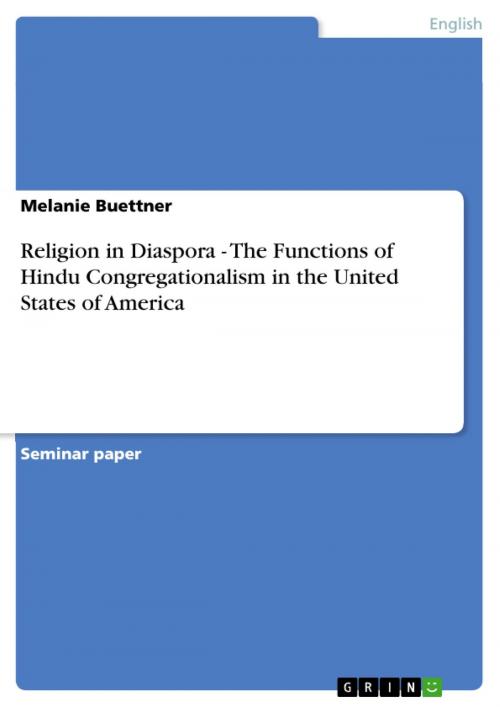Religion in Diaspora - The Functions of Hindu Congregationalism in the United States of America
The Functions of Hindu Congregationalism in the United States of America
Nonfiction, Reference & Language, Study Aids, ESL, Foreign Languages| Author: | Melanie Buettner | ISBN: | 9783640626588 |
| Publisher: | GRIN Publishing | Publication: | May 19, 2010 |
| Imprint: | GRIN Publishing | Language: | English |
| Author: | Melanie Buettner |
| ISBN: | 9783640626588 |
| Publisher: | GRIN Publishing |
| Publication: | May 19, 2010 |
| Imprint: | GRIN Publishing |
| Language: | English |
Seminar paper from the year 2010 in the subject English Language and Literature Studies - Culture and Applied Geography, grade: 1,3, Carl von Ossietzky University of Oldenburg (Institut für Anglistik), course: The Indian Diaspora in History, Literature and Film, language: English, abstract: In her book A Place at the Multicultural Table: The Development of an American Hinduism Prema Kurien states that 'Hinduism has taken different forms in the countries where it has been transplanted, depending on the interaction between the social and cultural characteristics of the particular group of immigrants and the characteristics of the receiving society.' Only recently, starting in the early-1990s, has the paramount importance of immigrant religion in the host country been acknowledged by scholars in the field of Diaspora Studies. In terms of the Hindu Diaspora of the United States, research conducted by Diana L. Eck, Pyong Gap Min and Prema Kurien has been groundbreaking. Why and how has Hinduism changed in the American setting? In the U.S. organizations of Popular Hinduism have been created that do not exist in India. These include for example Hindu student organizations, local worship and singing groups (satsangs), as well as educational groups for children (bala vihars). Practices in Hindu Temples built in the U.S. have also undergone some modifications when compared with traditional Hindu temples in India. What are the functions of those local associations and the new practices in Hindu Temples? Were they perhaps founded to build an ethnic community and to preserve Indian traditions and culture in a foreign environment? Are they a means to resist assimilation into the American host country society? Or does Hinduism, quite to the contrary, serve as a vehicle for actually becoming American? To resolve all those questions outlined above I am going to analyze select organizations of Popular Hinduism in the U.S., starting with an examination of the local worship and children educational groups. Then I will turn to the discussion of the possible functions of the new practices in Hindu temples in the United States. I will end my paper with a short summary of my findings.
Seminar paper from the year 2010 in the subject English Language and Literature Studies - Culture and Applied Geography, grade: 1,3, Carl von Ossietzky University of Oldenburg (Institut für Anglistik), course: The Indian Diaspora in History, Literature and Film, language: English, abstract: In her book A Place at the Multicultural Table: The Development of an American Hinduism Prema Kurien states that 'Hinduism has taken different forms in the countries where it has been transplanted, depending on the interaction between the social and cultural characteristics of the particular group of immigrants and the characteristics of the receiving society.' Only recently, starting in the early-1990s, has the paramount importance of immigrant religion in the host country been acknowledged by scholars in the field of Diaspora Studies. In terms of the Hindu Diaspora of the United States, research conducted by Diana L. Eck, Pyong Gap Min and Prema Kurien has been groundbreaking. Why and how has Hinduism changed in the American setting? In the U.S. organizations of Popular Hinduism have been created that do not exist in India. These include for example Hindu student organizations, local worship and singing groups (satsangs), as well as educational groups for children (bala vihars). Practices in Hindu Temples built in the U.S. have also undergone some modifications when compared with traditional Hindu temples in India. What are the functions of those local associations and the new practices in Hindu Temples? Were they perhaps founded to build an ethnic community and to preserve Indian traditions and culture in a foreign environment? Are they a means to resist assimilation into the American host country society? Or does Hinduism, quite to the contrary, serve as a vehicle for actually becoming American? To resolve all those questions outlined above I am going to analyze select organizations of Popular Hinduism in the U.S., starting with an examination of the local worship and children educational groups. Then I will turn to the discussion of the possible functions of the new practices in Hindu temples in the United States. I will end my paper with a short summary of my findings.















